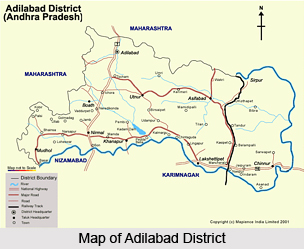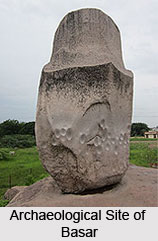 Adilabad District is a district located in Telangana. This district was earlier included with Andhra Pradesh. Adilabad District also comprised of major cities and towns like Mancherial, Chinnur, Adilabad, Nirmal, Bellampally, Kagaznagar, Mandamarri, Bhainsa, and Utnoor.
Adilabad District is a district located in Telangana. This district was earlier included with Andhra Pradesh. Adilabad District also comprised of major cities and towns like Mancherial, Chinnur, Adilabad, Nirmal, Bellampally, Kagaznagar, Mandamarri, Bhainsa, and Utnoor.
Location of Adilabad District
Adilabad District is a district in Telangana. On the North, the district is bounded by Yeotmal. On the east by, Chanda District, on the South by Karimnagar District and Nizamabad district and on the West by Nanded district of Maharastra State. Adilabad District is situated between 77.46 degree East and 80.01 degree East, of the eastern longitudes and 18.40 degree North and 19.56 degree North of northern latitudes.
Adilabad district occupies an area of 16,128 km square. The Sahyadri Mountains or Satnala range traverses the district from the north-west to the south-east for about 281.5 kilometers. The rivers that drain the district are the Godavari River, the Penganga River, Wardha River and Pranahita River. The two tributaries of the Godavari River are Kadam River and the Peddavagu River. Godavari River rises in the Western Ghats and enters this district near Basara, which is in the Mudhole Taluk.
The climate of Adilabad District is characterized by hot summer. The place experiences a dry climate in general. Rainfall is received during the south-west monsoon season. The normal annual rainfall of the district is 1044.5 m.m. Cold weather commences towards the end of November. The coldest month is December.
History of Adilabad District
 Adilabad District derives its name from the ruler of Bijapur, Ali Adil Shah. The district witnessed the rise and fall of different dynasties namely, the Mauryan Empire (Dynasty), Satavahana Dynasty, Vakataka Dynasty, Chalukyas of Badami, Rashtrakuta Dynasty, Chalukyas of Kalyani, Mughals, Bhosle Rajes of Nagpur and Asaf Jahis.
Adilabad District derives its name from the ruler of Bijapur, Ali Adil Shah. The district witnessed the rise and fall of different dynasties namely, the Mauryan Empire (Dynasty), Satavahana Dynasty, Vakataka Dynasty, Chalukyas of Badami, Rashtrakuta Dynasty, Chalukyas of Kalyani, Mughals, Bhosle Rajes of Nagpur and Asaf Jahis.
In 1905, Adilabad District was carved out of a sub district named Sirpur-Tandur. Historically the city was open to diverse variety of cultures as it was ruled by different rulers. At present, the district incorporates elements of Marathi culture into its native Telegu culture. Adilabad was once part of Maharashtra but its borders changed since 1945 and hence became a town in Telangana.
Demography of Adilabad District
In 2011, Adilabad District had a population of 2,741,239. Out of which male and female were 1,369,597 and 1,371,642 respectively. The population of Adilabad District constituted 3.24 percent of total Maharashtra population. There was change of 10.18 percent in the population compared to population as per 2001. The average literacy rate of Adilabad District in 2011 was 61.01 percent compared to 52.68 percent of 2001. The male and female literacy were 70.81 and 51.31 respectively. The total literate in Adilabad District were 1,483,347 of which male and female were 856,350 and 626,997 respectively. In 2001, Adilabad District had 1,112,189 in its district.
Divisions of Adilabad District
 The Adilabad district comprises of 52 Mandals and 1743 villages. Out of the 1743 villages 1557 villages are inhabited and 186 villages are un-inhabited. The district has 7 municipalities. The district is divided into five divisions that are Adilabad, Nirmal, Utnoor, Asifabad and Mancherial.
The Adilabad district comprises of 52 Mandals and 1743 villages. Out of the 1743 villages 1557 villages are inhabited and 186 villages are un-inhabited. The district has 7 municipalities. The district is divided into five divisions that are Adilabad, Nirmal, Utnoor, Asifabad and Mancherial.
Economy of Adilabad District
Agriculture is the main economy of the people of Adilabad District. Most of the people are farmers. The total cropped area of the district is 5.93 lakh hectares, which constitute 37% of the total geographical area. The principal crops are jowar, paddy, cotton, wheat, maize, chillies, sugarcane and soya. The area at present under the plantations and horticulture crops is only about 3.5% of the net area cultivated in the district. Horticulture produce assumes importance for it provides, supplementary income including foreign exchange and employment. The cultivable wastes and fallow lands can be put to use by plantation on the contours and bunds of the farmlands. With the above average rainfall, the district is suitable for horticulture comprising of fruits, vegetables and flowers. There are areas where medicinal and aromatic plants are cultivated. Sericulture is another form of economy in Adilabad District. Less than thousand areas of Adilabad District are under mulberry cultivation. Due to the heavy amount of transactions involved in cotton business, this city is also known as "City of Cotton". Animal Husbandry is only second to agriculture in terms of contributing to the gross income and employment in the district. The livestock consists of cattles, buffaloes, sheep, goats, poultry etc.
Tourism in Adilabad District
Adilabad District has a number of tourism spots which include Kuntala waterfalls, Pochera waterfalls, Ruyadi piris, Mathadivagu project in the district as part of a new plan for tourism promotion. Pochera waterfall is situated about 6 km. from the National Highway 7 in Neredigonda mandal. While on the other hand, Kuntala waterfall is situated about 12 km. away from the National Highway 7 from Neredigonda mandal headquarters. There are other tourist attraction spots like Kawal Wildlife Sanctuary, Sivaram Wildlife Sanctuary, Pranahitha Wildlife Sanctuary, SRSP Project Dam, Kadem Dam, Sathnala Dam, Penganga Reservoir. It is believed that the famous astronomer Aryabhatta wandered in this region. Some of the other temples and mosques in this district are Jama Masjid, Gulzar Masjid, Madina Masjid, Nagoba temple, Satyanarayana temple, Convent Church, Pranahita Wildlife Sanctuary and Shivaram Wildlife sanctuary.






